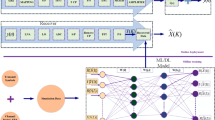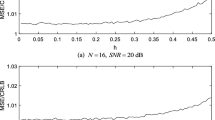Abstract
A method based on a sparse auto-encoder (SAE) network for the estimation of spreading sequences in long-code direct-sequence code-division multiple access (LC-DS-CDMA) signals is proposed. First, a network classification model based on SAE and softmax classifier is established. Next, the effectiveness of the proposed method is verified by estimating Walsh sequences and m sequences. To estimate the spreading sequences, the LC-DS-CDMA signal is divided into fragments. Then, each user’s spreading sequence is separated by the fast independent component analysis (Fast-ICA) algorithm, and the amplitude fuzziness is eliminated by the delay-and-multiply method. Finally, the spreading sequences are estimated by the SAE model. Experimental results showed that the proposed algorithm could effectively estimate the spreading sequences of LC-DS-CDMA signals. Compared to the existing matching algorithm and Fast-ICA algorithm, the estimation time required by the proposed algorithm was shorter, and its estimation performance at low signal-to-noise ratios was superior.








Similar content being viewed by others
References
Yao Y, Poor HV (2001) Eavesdropping in the synchronous CDMA channel: an EM-based approach. IEEE Trans Signal Process 49(8):1748–1756
Haghighat A, Soleymani MR (2005) A MUSIC-based algorithm for blind user identification in multiuser DS-CDMA. EURASIP J Adv Signal Process 5:649–657
Qiu PY, Huang ZT, Jiang WL, Zhang C (2010) Blind multiuser spreading sequences estimation algorithm for the direct-sequence code division multiple access signals. IET Signal Process 4(5):465–478
Rouijel A, Minaoui K, Comon P, Aboutajdine D (2014) CP decomposition approach to blind separation for DS-CDMA system using a new performance index. EURASIP J Adv Signal Process 2014:128
Lu FB, Huang ZT, Jiang WL (2011) Blind estimation of spreading sequence of CDMA signals based on Fast-ICA and performance analysis. J Commun 32(88):136–142
Ren XT, Xu H, Huang ZT, Wang FH, Lu FB (2012) Fast-ICA based optimize blind estimation of spreading sequence of CDMA signals. Acta Electronica Sinica 40(8):1532–1538
Zhao ZJ, Qiang FF, Li M, Shen L, Wang HQ (2017) Blind estimation of pseudo-random noise codes in NPLSC-DSSS signals based on goodness of fit test. J Electron Inf Technol 39(3):749–753
Zhao ZJ, Gu XW, Qiang FF, Shen L (2017) Blind estimation of PN codes in multi-user LSC-DSSS signals. J Commun 12(1):55–61
Zhang HG, Wei P (2011) Blind despreading of synchronous multi-user long-code DS-SS signals. J Electron Inf Technol 33(7):1748–1751
Zhang TQ, Tian ZS, Chen QB, Lin XK, Zhou ZZ (2006) Use APEX neural networks to extract the PN sequence in lower SNR DS-SS signals. In: International conference on intelligent computing, Kunming, China, pp 1252–1257
Zhao DF, Zhang TQ, Jin X, Du XH (2010) DSSS signal spread spectrum codes blind identification based on BP neural network. Telecommun Eng 50(10):28–35
Zhao JT, Zhang TQ, Jiang XL, Ma BZ (2017) Blind estimate of PN sequence synchronous DS-CDMA based on LEAP neural network. Appl Res Comput 34(2):552–556
Zhang TQ, Zhao JT, Jiang XL (2016) PN code sequence blind estimate of synchronous DS-CDMA based on multi-principal component neural network. Syst Eng Electron 38(11):2638–2647
Dolz J, Betrouni N, Quidet M et al (2016) Stacking denoising auto-encoders in a deep network to segment the brainstem on MRI in brain cancer patients: a clinical study. Comput Med Imaging Graph 52:8–18
Kang K, Sun HB, Zhang CK, Carl B (2019) Short-term electrical load forecasting method based on stacked auto-encoding and GRU neural network. Evol Intel. https://doi.org/10.1007/s12065-018-00196-0
Sun W, Shao S, Zhao R, Yan R, Zhang X, Chen X (2016) A sparse auto-encoder-based deep neural network approach for induction motor faults classification. Measurement 89:171–178
Rajaguru H, Prabhakar SK (2017) Logistic regression Gaussian mixture model and softmax discriminant classifier for epilepsy classification from EEG signals. In: IEEE international conference on computing methodologies and communication, Erode, India, pp 985–988
Purohit G, Vyas D, Chaubey VK, Raju KS, Shekhar C (2019) A new XOR-Free approach to implement Walsh sequences. Wirel Pers Commun. https://doi.org/10.1007/s11277-019-06549-x
Li J, Liu N, Liu HM, Sun Y, He ZS (2013) A method of orthogonal polyphase code sequence design based on Walsh matrix. Chin J Radio Sci 28(3):577–583
Guo LL, Wu YH, Zhang XL (2002) A new method of generating Walsh functional sequence. J Harbin Eng Univ 23(1):99–102
Zhang TQ, Zhao L, Zhang T, Yang K (2018) A blind recognition method of binary pseudo-random sequence. J Electron Inf Technol 40(2):394–399
Bengio Y (2012) Practical recommendations for gradient-based training of deep architectures. In: Montavon G, Orr GB, Müller KR (eds) Neural network: tricks of the trade. Lecture notes in computer science, vol 7700. Springer, Berlin, Heidelberg, pp 437–478
Acknowledgements
We acknowledged our sincere thanks to all anonymous reviewers for their insightful comments and constructive suggestions to polish this paper in high quality. This research was supported by the National Natural Science Foundations of China (No. 61571172), Zhejiang Provincial Key Lab of Data Storage and Transmission Technology and the open project of Zhejiang Provincial Key Laboratory of Information Processing, Communication and Networking. We acknowledged our sincere thanks to them for their encouragement and valuable support.
Author information
Authors and Affiliations
Corresponding author
Additional information
Publisher's Note
Springer Nature remains neutral with regard to jurisdictional claims in published maps and institutional affiliations.
Rights and permissions
About this article
Cite this article
Qiang, F., Zhao, Z., Shang, J. et al. Estimation of spreading sequences in LC-DS-CDMA signals based on sparse auto-encoder. Evol. Intel. 13, 235–246 (2020). https://doi.org/10.1007/s12065-019-00298-3
Received:
Revised:
Accepted:
Published:
Issue Date:
DOI: https://doi.org/10.1007/s12065-019-00298-3




